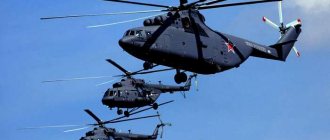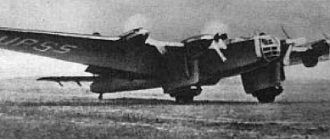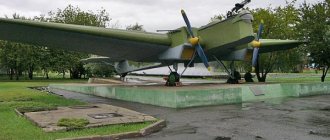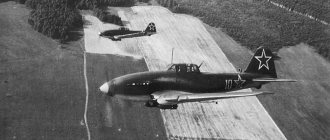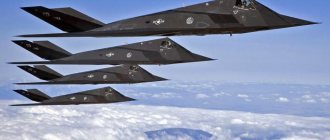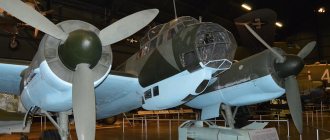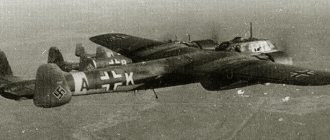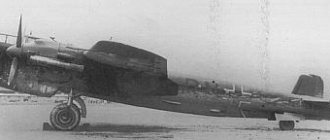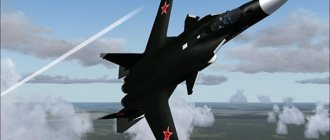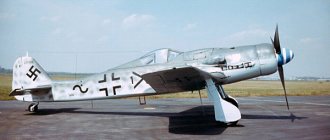Transport aircraft | USA
Transport aircraft Beech C-45 Expeditor
The aircraft was a military version of the civil transport aircraft B-18S and was produced since 1940. It was an all-metal low-wing aircraft with a semi-monocoque fuselage made of light alloys, with a cantilever tail unit, which included a two-fin vertical fin, and an electrically retractable landing gear with a tail wheel. During the war, about 1.5 thousand vehicles of the following modifications were built: S-45, S-45AA, S-45B and S-45F. The aircraft were also used in the UK under the designation Expeditor I/III. Performance characteristics of the vehicle: length – 10.4 m; height – 3 m; wingspan - 14.5 m; wing area – 32.4 m²; empty weight – 2.8 t, take-off weight – 4 t; engines - two Pratt & Whitney R-985 450 hp; rate of climb – 9.4 m/s; maximum speed – 360 km/h; practical range – 1,900 km; practical ceiling – 7,900 m; crew – 2 people; payload – 6 passengers.
Transport aircraft Douglas DC-2
The light transport aircraft was produced in 1934-1939. based on DC-1. The aircraft was an all-metal low-wing aircraft with a semi-monocoque fuselage, a cantilever wing and tail unit, and a tricycle retractable landing gear with a tail wheel. A total of 90 military vehicles were built under the designation C32/33/39. The aircraft was also used in Australia, Great Britain and Germany. Performance characteristics of the vehicle: length – 18.9 m; height – 5 m; wingspan - 25.9 m; wing area – 87.3 m²; empty weight – 5.7 t, take-off weight – 8.4 t; engines - two Wright R-1820 with a power of 710 - 975 hp; rate of climb – 310 m/m; maximum speed – 340 km/h, cruising speed – 300 km/h; practical range – 1,700 km; practical ceiling – 6,800 m; crew – 2 – 3 people; payload – 16 passengers and 450 kg of cargo.
Transport aircraft Douglas C-47 Skytrain (R-4D-1)
The aircraft was a military version of the Douglas DC-3 civilian transport aircraft, which was produced on the basis of the DC-2. It was produced in 1942-1945. and was a cantilever low-wing aircraft of an all-metal structure with the exception of fabric covering on the control surfaces. The aircraft had a fuselage with a round cross-section, a retractable tricycle landing gear with a self-orienting tail wheel and a cantilever tail. A cargo door was located on the left side. In total, about 10 thousand vehicles were built in 5 serial modifications, in particular: S-47, S-47A-T, Dakota Mk I/IV. 707 vehicles were delivered to the USSR under the Lend-Lease agreement. Under the designation Dakota, 1.9 thousand vehicles were delivered to the UK. Performance characteristics of the vehicle: length – 19.4 m; height – 5.2 m; wingspan - 29.1 m; wing area – 91.7 m²; empty weight – 8.1 t, take-off weight – 14 t; engines - two Pratt Whitney R-1830 with a power of 1,200 hp; rate of climb – 345 m/m; maximum speed – 370 km/h, cruising speed – 260 km/h; practical range – 2,600 km; practical ceiling – 7,300 m; crew – 3 people; payload – 28 passengers or 2.7 tons of cargo.
Transport aircraft Douglas C-54 Skymaster (R-5D)
The aircraft was a military version of the civil long-range transport aircraft Douglas DC-4, which was produced on the basis of the DC-3. It was an all-metal cantilever low-wing aircraft with a large round fuselage and a retractable tricycle landing gear. The aircraft had a nose landing gear instead of a tail wheel, a reinforced floor, a cargo door and loading equipment. It has been produced since 1942 in the following main serial modifications: S-54, S-54A, S-54B, S-54D, S-54E, S-54F, C-54G, S-54N and R-5D. A total of 1.2 thousand cars were built. The aircraft was also used in the UK (under the designation Skymaster Mk-1) and Canada. Performance characteristics of the vehicle: length – 28.6 m; height – 8.4 m; wingspan - 35.8 m; wing area – 136 m²; empty weight - 17.7 tons, take-off weight - 33 tons; engines - four Pratt Whitney R-2000 with a power of 1,450 hp; maximum speed – 420 km/h, cruising speed – 310 km/h; practical range – 6,400 km; practical ceiling – 6,800 m; crew – 4 people; payload – 50 passengers or 14.7 tons of cargo.
Transport aircraft Douglas C-110 (R3D)
The aircraft was a version of the Douglas DC-5 civil transport aircraft and was produced in 1939. It was an all-metal cantilever high-wing aircraft with a tricycle retractable landing gear and a sliding cargo door. The plumage is all-metal, single-finned. A total of 7 cars were built. Vehicle performance characteristics: length – 19 m; height – 6 m; wingspan - 23.8 m; wing area – 76.6 m²; empty weight – 6.2 t, take-off weight – 9.1 t; engines - two Wright GR-1820-F62 Cyclone 900 hp; rate of climb – 8.1 m/s; maximum speed – 370 km/h, cruising speed – 320 km/h; practical range – 2,600 km; practical ceiling – 7,200 m; crew – 3 people; payload – 18-22 passengers.
Transport aircraft Consolidated C-87 Liberator Express
The aircraft was a transport version of the B-24D Liberator bomber and was produced in 1942-1944. Rectangular windows and a large door were made on the sides of the fuselage, and 25 seats were installed for passengers. A total of 287 vehicles were built in six versions. Aircraft were also delivered to the UK. Vehicle performance characteristics: length – 20.2 m; height – 5.5 m; wingspan - 33.5 m; wing area – 97.4 m²; empty weight - 13.9 tons, take-off weight - 25.4 tons; engines - four Pratt & Whitney R-1830-43 with a power of 1,200 hp; maximum speed – 480 km/h, cruising speed – 350 km/h; practical range – 2,200 km; practical ceiling – 8,500 m; crew – 4 people; payload – 25 passengers or 4.5 tons of cargo.
Transport aircraft Curtiss-Wright C-46 Commando
The average transport twin-engine aircraft was produced in 1942-1945. based on the CW-20 passenger aircraft. It had a cargo door on the port side at the rear of the fuselage, a reinforced cargo compartment floor and folding seats for 40 people. A total of 3.2 thousand vehicles were built in the following modifications: C-46, C-46A, C-46C, C-46 D, C-46E and C-46F. Vehicle performance characteristics: length – 23.3 m; height – 6.6 m; wingspan - 32.9 m; wing area – 126.8 m²; empty weight – 14.7 t, take-off weight – 22 t; engines - two Pratt & Whitney R-2800-51 with a power of 2,000 hp; rate of climb – 6.6 m/s; maximum speed - 430 km/h, cruising speed - 280; practical range – 4,700 km; practical ceiling – 8,400 m; crew – 4 people; payload – 40-54 passengers.
Transport aircraft Curtiss-Wright C-76 Caravan
The medium transport twin-engine aircraft was produced in 1943. It was a high-wing aircraft of all-wood construction. A total of 25 vehicles were built, five of which entered service with the US Air Force. Vehicle performance characteristics: length – 20.8 m; height – 8.3 m; wingspan - 32.9 m; wing area – 144.9 m²; empty weight – 8.3 t, take-off weight – 12.7 t; engines - two Pratt & Whitney R-1830-92 with a power of 1,200 hp; rate of climb – 244 m/m; maximum speed - 300 km/h, cruising speed - 280; practical range – 1,200 km; practical ceiling – 6,900 m; crew – 3 people; payload – 45 passengers.
Transport aircraft Fairchild -24 (UC-61)
The aircraft was developed on the basis of the Model 22-C7 series aircraft. It was produced as a military version since 1941. The aircraft was a strut-braced high-wing aircraft with a closed cockpit and a fixed landing gear with a tail wheel. In total, 1.5 thousand vehicles were built before the end of the war. The aircraft was delivered under the Lend-Lease agreement to England as Argus Mk-I/III. Vehicle performance characteristics: length –7.2 m; height – 2.2 m; wingspan - 11.1 m; wing area – 16.9 m²; empty weight – 670 kg, take-off weight – 1.1 t; engine – Warner Super Scarab with a power of 145-200 hp; rate of climb – 200 m/m; maximum speed – 210 km/h, cruising speed – 190; practical range – 800 km; practical ceiling – 5,000 m; crew – 1 person; payload – 3 passengers.
Transport aircraft Lockheed C-36 (L-10 Electra)
The civil twin-engine aircraft L-10 Electra was produced since 1934. It was a cantilever low-wing aircraft with a retractable landing gear with a tail wheel and a twin-tail tail. A total of 149 vehicles were built. Since the outbreak of war, the aircraft were used by the army under the designation C-36, both in the United States, Great Britain and Canada. Vehicle performance characteristics: length – 11.8 m; height – 3.1 m; wingspan - 16.8 m; wing area – 42.5 m²; empty weight – 2.9 t, take-off weight – 4.8 t; engines - two Pratt & Whitney SB with a power of 400-550 hp; fuel tank volume – 734 l; rate of climb – 5 m/s; maximum speed – 320 km/h, cruising speed – 290 km/h; practical range – 1,400 km; practical ceiling – 5,900 m; armament - two 12.7 mm machine guns; bomb load - 900 kg; crew – 2 people; payload – 10 passengers.
Lockheed C-40 transport aircraft (L-12 Electra Junior)
The civil twin-engine aircraft L-12 Electra Junior was produced in 1936-1941. and was a modernized, smaller version of the L-10 Electra. A total of 130 vehicles were built. Since the beginning of the war, the aircraft served in the army under the designation C-40, both in the USA and in Holland and Canada. Performance characteristics of the vehicle: length – 11.1 m; height – 3 m; wingspan - 15.1 m; wing area – 32.7 m²; empty weight – 2.6 t, take-off weight – 4.2 t; engines - two Pratt & Whitney R-985 450 hp; rate of climb – 427 m/m; maximum speed – 360 km/h; practical range – 1,300 km; practical ceiling – 6,900 m; armament - two 12.7 mm machine guns; bomb load - 900 kg; crew – 2 people; payload – 6 passengers.
Lockheed C-60 (L-18 Lodestar) transport aircraft
The aircraft was a variant of the L-18 Lodestar passenger aircraft and was produced in 1940-1943. . It was a twin-engine all-metal monoplane with a twin-tail tail and retractable landing gear. A total of 480 vehicles were built in the following modifications: C-56, C-57, C-60 and R5O. The aircraft were also used in Australia, Brazil, Great Britain, Holland, Canada and New Zealand.
Lockheed C-60 (L-18 Lodestar) transport aircraft
Vehicle performance characteristics: length – 15.2 m; height – 3.6 m; wingspan – 20 m; wing area – 51.2 m²; empty weight – 5.7 t, take-off weight – 9.8 t; engines - two Wright R-1820 1,200 hp; maximum speed – 428 km/h, cruising speed – 320 km/h; practical range – 4,000 km; practical ceiling – 7,700 m; crew – 3 people; payload – 14-18 passengers.
Lockheed C-69 Constellation transport aircraft
The aircraft was a civil airliner L-49 and was produced in 1943-1945. The US Air Force used 21 vehicles under the designation C-69 Constellation. Vehicle performance characteristics: length – 29 m; height – 7.2 m; wingspan - 37.5 m; wing area – 153.3 m²; empty weight - 22.9 tons, take-off weight - 32.7 tons; engines - four Wright R-3350 with a power of 2,200 hp; maximum speed – 530 km/h, cruising speed – 480 km/h; practical range – 3,800 km; practical ceiling – 7,600 m; crew – 4 people; payload – 81 passengers.
Transport aircraft Lockheed 14 (C-111)
The L-14 Super Electra aircraft was produced since 1937 based on the L-10 Electra.
It had a mid-wing and solid wing fuel tanks. A total of 354 vehicles were built, incl. Japanese - 119 and Kawasaki - 121. Performance characteristics of the vehicle: length - 13.5 m; height – 3.5 m; wingspan – 20 m; wing area – 51.2 m²; empty weight – 4.7 t, take-off weight – 7.9 t; engines - two Pratt Whitney Hornet S1E-G with a power of 760 - 875 hp; maximum speed – 398 km/h, cruising speed – 376 km/h; practical range – 3,300 km; practical ceiling – 7,400 m; crew – 2 people; payload – 12-14 passengers. Share to:
An-22 "Antey"
This is the first Soviet wide-body aircraft, which is still the largest turboprop transport vehicle. The An-22 was created by the Antonov Design Bureau in 1964 and was designed taking into account the possibility of transporting all military equipment available in the country at that time - weighing up to 50 tons.
The carrying capacity of the Antey was 60,000 kilograms, and the wingspan reached 64.4 meters. Named after the mythical giant who lost strength when lifted off the ground, the An-22 turned out to be one of the most successful aircraft of its class. A total of 68 vehicles were built, of which five are still engaged in transportation (four in Russia and one in Ukraine).
An-124 "Ruslan"
A heavy long-range transport aircraft developed by the Antonov Design Bureau, originally created to transport mobile launchers of intercontinental ballistic missiles, now operates as an aircraft for transporting large-sized and non-standard cargo. This is the largest commercially produced aircraft, with a wingspan of 73.3 meters and a length of almost 70 meters. "Ruslan" can transport up to 120 tons of cargo.
The An-124 made its first flight in 1982; out of 55 aircraft created, more than 40 are still in operation. Among the cargo it transported are: the Aksum obelisk (160 tons - in three stages), a locomotive weighing 109 tons (at one time), a stage equipment for a Michael Jackson concert (310 tons over three flights).
Lockheed C-5 Galaxy
American strategic military transport aircraft with increased payload capacity. It can carry up to 118 tons of cargo, which makes it the third largest cargo capacity in the world. Galaxy is capable of lifting six McDonnell Douglas AH-64 Apache helicopters or six M1126/M1135 Stryker armored personnel carriers or two M1 Abrams tanks at once, and up to 345 soldiers. Its wingspan is almost 68 meters. A total of 131 vehicles were built, more than thirty of which continue to serve in the American army to this day.
An-225 "Mriya" (Dream)
This aircraft exists in only one copy and was created specifically as part of the aviation transport system for the Buran reusable spacecraft project. The main task of the Mriya was to transport various components of the launch vehicle and spacecraft from the production and assembly site to the launch pad. It was also planned to use the aircraft as a platform for the air launch of a spacecraft. Stratolaunch Systems created its own aircraft for the same purpose.
The carrying capacity of the An-225 is 250 tons with the possibility of both internal and external cargo placement. Its wingspan is 88.4 meters and its length is 84 meters. On March 22, 1989, the An-225 broke 110 world records at the same time, flying with a load of 156.3 tons. In August 2004, Mriya set a new record by transporting 250 tons of special equipment ordered by Zeromax GmbH from Prague to Tashkent.
Taking into account Stratolaunch, four of the six giant aircraft were created in the USSR and Russia, but the rapid growth of private American aerospace companies such as Virgin Galactic, Blue Origin, Stratolaunch Systems, etc., calls into question the leading position of Russian design bureaus in the field of creating very large transport aircraft. At the same time, the prospects for the development of space tourism and suborbital launch of spacecraft can make the production of such equipment an extremely promising industry.
